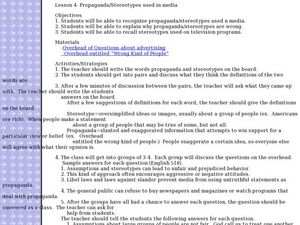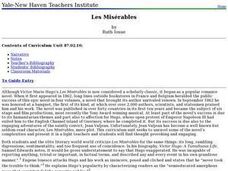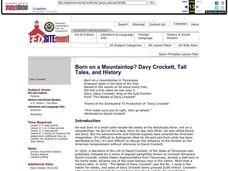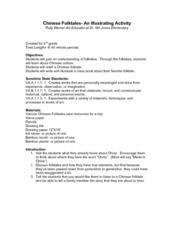Curated OER
Propaganda/Stereotypes Used in the Media
Students write a character sketch on a television character who they feel is a stereotype. In this propaganda/stereotype instructional activity, students discuss the definition of the terms and ways that the media uses both. ...
Curated OER
The Lost Flyer
Fourth graders, using Microsoft Word, create a notice of a lost pet flyer. They use a border, exaggerated fonts, colors and clip art.
Curated OER
Integrating Past Continuous
Students recognize the situations in which the use of the past continuous would be beneficial in writing. They focus on the use of the past continuous as a descriptive tense when something important occurred.
Curated OER
Be An Incredible Songwriter
Students write songs about something incredible they have experienced or know about. They consider topics of events, dreams, ideas, feelings, or animals. They accompany themselves with small musical instruments while performing the songs...
Curated OER
Lead Stories about Confederation Lesson 5
Students identify what a lead story is and how to write one, for their simulated newspaper, about Confederation. They use primary-source documents from the "EvidenceWeb" portion of the Learning Centre, on the Library and Archives Canada...
Curated OER
Stretching It
Students recognize the use of exaggeration and understand how it may enhance the story, painting, conversation or event. Students transfer their understanding of exaggeration as it is used in many places, ie., daily life, paintings,...
Curated OER
Car Adverts: Tell It Like It is
Students explore the strategies and bias that are sometimes used in advertising with a particular focus on automobile advertising. Working in groups, they read several car ads and discuss the bias, opinion and stereotyping in the ads as...
Curated OER
Alliteration
In this alliteration worksheet, 4th graders write alliterations with their first names, find rhyming patterns in poems, and more. Students complete 4 activities.
Curated OER
Spanish-American War
Middle schoolers view a video called Battling Beyond the Borders about the Spanish-American War. They discuss the role of newspapers in the war and then analyze political cartoons of the time, writing explanatory sentences about them.
Curated OER
Les Mis'rables
Young scholars read, understand, and enjoy Les Miserables. They improve their skills in literary analysis, writing, and listening. Through the study of biblical and historical allusions, symbols, metaphors, and other figurative language,...
Curated OER
Propaganda and Its Effects on WWI
Young scholars learn about propaganda. In this WWI lesson, students define the term propaganda. Working in groups, they are given a packet of postcards and posters used during WWI. They answer questions about their uses and write a...
Curated OER
Born on a Mountaintop? Davy Crockett, Tall Tales, and History
Students name tall tale characters and locations, which are based on actual people and places, and describe how they are used in an exaggerated way. Students name created characters and events from tall tales. Students write a tall tale.
Curated OER
How I Spent My Summer Vacation
Students hear the story How I Spent My Summer Vacation by Wallace Bleef and share their own summer experiences. They write a tale about one event that happened during their summer using exaggeration.
Curated OER
Bunyan, Appleseed, and More
Ninth graders listen to a variety of tall tales and compose their own tall tale. In this tall tale lesson, 9th graders complete KWL chart about tall tales. Students discuss the elements of tall tales and then read example tales....
Curated OER
Hyperbole
Young scholars define the term hyperbole and determine when it is appropriate to use hyperboles in writing. They work in pairs to develop short stories and poems with examples of hyperboles.
Curated OER
When I'm 75
Students pretend they are a senior adult, around 75 years old. After observing pictures of older people, students write sentence, using future perfect and future continuous to answer questions. In pairs, they complete a worksheet and...
Curated OER
Social Studies: In Search of Al Qaeda
Students discuss the themes in the documentary In Search of Al Qaeda. following a class discussion, they write responses to the statement, Information about Al Qaeda will never be completely accurate.
Curated OER
The Air Up There
Students engage in a lesson that is concerned with the average daily weather patterns. They collect data over a five day period and then write a summary of the observations made from it. Students record the mean and graph it on a simple...
Curated OER
Tell a Ton of Tall Tales
Elementary schoolers read many tall tales. They create their own tall tale about a specific event of their choosing. They must act the part of the author. This well-designed lesson takes three class sessions to complete, and is...
Curated OER
Chinese Folktales: An Illustrating Activity
In need of a really good lesson that incorporates literature, art, and cultural themes? After hearing a traditional Chinese folktale and discussing cultural themes and symbolism, learners create original illustrations for the story. This...
Curated OER
How to Draw Caricatures
Caricature drawing is fun, and can help learners explore the principle of design and content specific vocabulary. They view a video and books that use character drawings, discuss vocabulary such as exaggeration, proportion, and symmetry,...
Curated OER
Sculpture in Balance
Young scholars discuss the difference betwen two-dimensional vs. three-dimensional art. In this art lesson, students discuss what symmetry or balance is in art and construct a symmetrical and an asymmetrical mobile.
PBS
Myth of the West: Kit Carson to the Rescue
There's nothing like the Wild Wild West! Scholars investigate the American Frontier through the eyes of Kit Carson. To complete the first installment of a three-part series, they use presentations, a short video, and primary and...
Curated OER
Perceived Risks
Young scholars rank a list of everyday risks to compare with classmates. They rate each risk on both its ability to be controlled and its observability in the environment. Results are graphed.























